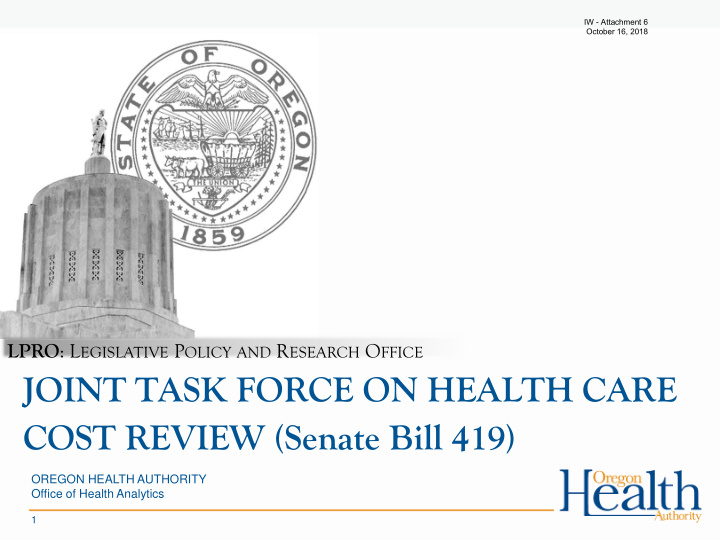



IW - Attachment 6 October 16, 2018 LPRO : L EGISLATIVE P OLICY AND R ESEARCH O FFICE JOINT TASK FORCE ON HEALTH CARE COST REVIEW (Senate Bill 419) OREGON HEALTH AUTHORITY Office of Health Analytics 1
IW - Attachment 6 October 16, 2018 SB 419 Task Force Charge Senate Bill 419 (2017) established the Joint Interim Task Force on Health Care Cost Review to study the feasibility of creating a hospital rate-setting process in Oregon modeled on the process used by the Health Services Cost Review Commission in Maryland. Specifically, the Task Force sought to: • explore opportunities to limit the growth of health care expenditures in Oregon • address cost drivers in Oregon, with initial focus on hospital costs • assess potential impact and feasibility of the Maryland model • consider and evaluate alternative models to accomplish the goals in Senate Bill 419 OREGON HEALTH AUTHORITY Office of Health Analytics 2
IW - Attachment 6 October 16, 2018 Summary of Task Force Activity • Sixteen-member Task Force invested over 1,000 hours into examining the Maryland model, hearing from national and state health policy experts, and working to develop a consensus around a set of recommendations designed to contain health care cost growth in Oregon. • Task Force worked to assess opportunities and challenges associated with: • establishing models of accountable care organizations; • creating multi-payer and all-payer approaches to transform health care payment; and • key factors to consider in establishing a statewide benchmark to limit the annual rate of growth in health care expenditures. OREGON HEALTH AUTHORITY Office of Health Analytics 3
IW - Attachment 6 October 16, 2018 Key Policy Considerations • Promote cost containment • Support payment reform • Address price variation among payers and providers • Offer multi-payer approach (public and private) • Create fixed, stable, predictable rate of spending/growth • Build on Oregon’s successful 3.4 percent rate of growth in Medicaid • Promote accountability through reporting, transparency and public hearings • Remain true to Oregon’s unique health care environment. OREGON HEALTH AUTHORITY Office of Health Analytics 4
IW - Attachment 6 October 16, 2018 Task Force Findings The Task Force opted not to recommend adopting the Maryland hospital rate-setting model, at this time, based on the following: • Historical approach focuses on fee-for-service rather than paying for value and fails to align with Oregon’s payment reform efforts including incentivizing prevention and population health services. • Hospital care is a shrinking proportion of health care spending, and a hospital-based rate-setting system could potentially incentivize out- migration of care from regulated hospitals to unregulated outpatient providers (non-hospital providers). • Maryland’s rate-setting system is complex and administratively challenging to implement and maintain over time. • The model requires a federal Medicare waiver. OREGON HEALTH AUTHORITY Office of Health Analytics 5
IW - Attachment 6 October 16, 2018 Statewide Cost Growth Benchmark • Establish a single statewide benchmark for health care spending that is fixed, stable, predictable, and economically sustainable. • Develop and adopt a benchmark methodology to measure total cost of care across healthcare at the state level, and as practical, account for variations of patient mix, and geographic regions and workforce. • Ensure calculation of total health care expenditures encompass spending on all health cares services across the state for all populations. • Identify individual health care providers and payers who shall publicly report, and are to beheld accountable for staying at or below the benchmark. OREGON HEALTH AUTHORITY Office of Health Analytics 6
IW - Attachment 6 October 16, 2018 Statewide Cost Growth Benchmark (cont.) • Determine oversight entity responsible for maintaining and enforcing the benchmark; identify outlier costs, price variation, waste or inefficiency, and cost drivers that contribute to growth; and report annually to the Legislative Assembly. • Support market-oriented approach by enhancing public reporting, transparency, and collective accountability for spending for all providers and payers. • Align reporting and use of quality measures across payers and providers as foundational to the improvement and accountability structure for the benchmark. OREGON HEALTH AUTHORITY Office of Health Analytics 7
IW - Attachment 6 October 16, 2018 SB 419 Next Steps • Formal report with recommendations submitted to Legislative Assembly on Sept. 13, 2018 • Fall 2018 – drafting of legislative concept by Legislative Counsel • 2019 legislative session – introduce bill modeled after the Task Force recommendations OREGON HEALTH AUTHORITY Office of Health Analytics 8
IW - Attachment 6 October 16, 2018 SB419 impact on SB1067 Controlled SB419 SB1067 rate of Growth OREGON HEALTH AUTHORITY Office of Health Analytics 9
IW - Attachment 6 October 16, 2018 Questions? OREGON HEALTH AUTHORITY Office of Health Analytics 10
Recommend
More recommend